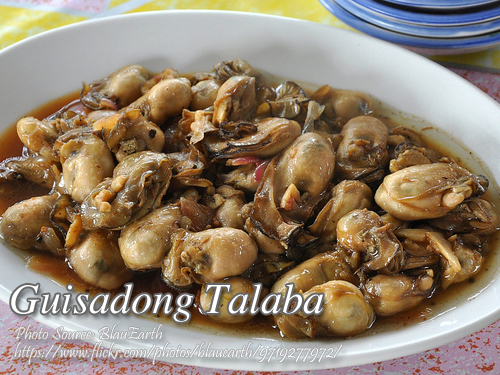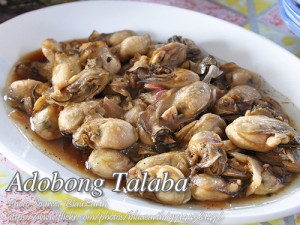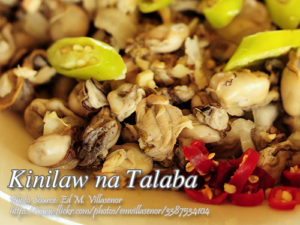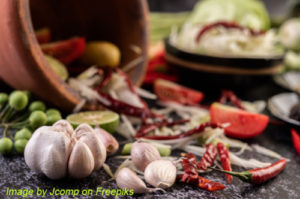This is a local dish of stir fried oyster meat with garlic, onions and tomatoes and of course spices and condiments. Actually “guisado” means stir-fry and stir frying oysters is one of the simplest and tastiest ways to cook oysters. A very simple and quick few minutes to cook recipe. Great for people who love oysters and to those who are in a hurry.
Guisadong Talaba: A Taste of the Sea with a Touch of Nostalgia
Whenever I think of sautéed oysters, I’m instantly transported to my grandmother’s kitchen in Cavite. Growing up near the coastline, seafood was a staple on our dining table. Oysters, in particular, were something we always had in abundance. My Uncle Lito, a seasoned fisherman, would come by with freshly harvested oysters from the bay, and without fail, my grandmother would whip up this simple yet flavorful dish that always made us feel at home. To this day, whenever I prepare this stir-fried oyster recipe, it reminds me of those gatherings where food brought us together.
A Quick and Flavorful Dish for Busy Days
Guisadong talaba is one of those dishes that doesn’t require hours in the kitchen, but still delivers layers of flavor with each bite. The beauty of this dish lies in its simplicity—garlic, onions, tomatoes, and of course, the fresh, briny oysters. It’s perfect for beginners, especially if you’re short on time but still want to prepare something that tastes like it took more effort than it did.
My sister Marites, who lives in Manila now, often makes this when she’s in a rush after a long day of work. She says it’s her go-to because it’s “easy, tasty, and reminds her of home.” She likes to toss it over rice, and the combination of juicy oysters with the subtle sweetness of sautéed garlic and onions always hits the spot.
Why Stir-Frying Works for Oysters
Stir-frying, or guisado, is one of the most popular cooking techniques in Filipino cuisine, and for good reason. It’s quick, and it helps preserve the natural flavors of the ingredients. When you stir-fry oysters, you only need a few minutes to cook them through, preserving their delicate, tender texture. Overcooking can make them rubbery, so it’s important to keep a close eye on them as they cook. My Aunt Virgie always says the trick to cooking oysters perfectly is to watch for the moment they begin to curl slightly—that’s when you know they’re done.
One key step in this recipe is sautéing the garlic and onions until they’re golden brown before adding the oysters. This process of gisa releases all the aromatic oils from the garlic and onions, creating a fragrant base that complements the briny, slightly sweet oysters. When you add the tomatoes next, their acidity helps balance out the richness of the dish.
A Taste of Tradition with a Modern Twist
What I love about oysters is its versatility. Growing up, we always had it the traditional way—just the oysters, sautéed vegetables, and simple seasoning. But nowadays, I like to experiment a little. Sometimes I add a splash of soy sauce for a bit more umami, or I toss in some fresh chili peppers for a spicy kick, something my cousin Boyet taught me when he returned from a trip to Bicol. It’s the kind of dish that allows you to make it your own while still keeping true to its roots.
One thing remains constant, though—the use of fresh, local ingredients. There’s really no substitute for oysters that have just been harvested. I remember once trying to recreate this dish while living abroad, using frozen oysters. While it was still good, it just didn’t have that same fresh, salty taste that I grew up with. If you have access to fresh oysters, I highly recommend using them for the best flavor.
A Simple Dish with Deep Roots
Stir-frying oysters might seem like a modern, quick fix, but guisado is actually an age-old technique that has been passed down through generations of Filipino cooks. Before modern kitchen appliances, sautéing was a way to bring out the maximum flavor from basic ingredients, and this is evident in dishes like guisadong talaba. It’s a dish that, while simple in ingredients, carries the weight of tradition and family memories.
In fact, in coastal provinces like ours, cooking with oysters is a way of life. Oysters have long been a valuable resource for Filipinos, not just because of their abundance, but also for their nutritional value. Packed with vitamins and minerals, they’ve been a go-to source of protein for families like mine who lived by the sea. This dish is a reflection of that—humble, nourishing, and deeply connected to the land (or sea, in this case) and the people who harvest it.
A Dish to Share with Loved Ones
Whenever I cook this dish, I’m reminded of those noisy Sunday lunches when the whole family gathered around the table. My cousins would be running around, my Lola giving instructions from the kitchen, and Uncle Lito recounting stories from his latest fishing trip. This dish always brought us together, its flavors connecting us to the sea that provided so much for our family.
Now, every time I serve it to my own family, I tell them the same stories my uncle once shared with me. I hope one day, they’ll pass these stories—and this recipe—onto their own children. Guisadong talaba isn’t just a dish; it’s a reminder of where we came from and the memories we carry with us.
So, if you’re looking for a dish that’s easy to make but full of flavor, give this stir-fried oyster recipe a try. Who knows? It might just become a part of your family’s tradition too.
How to Cook Guisadong Talaba
Ingredients
- 2 cup shelled oyster
- 1 tsp. chopped garlic
- 1/2 cup sliced onion
- 1/2 cup sliced tomatoes
- 2 Tbsp. cooking oil
- salt and pepper and MSG
- 1 pc red or green pepper optional
Instructions
How to cook Guisadong Talaba
- Saute garlic and onions until light brown. Then add tomatoes and cook for 2 minutes.
- Add oysters and red and green pepper and let boil for a few minutes.
- Season with salt and pepper and MSG. Serve hot. Good for 6 persons.
Notes
Cooking Tips:
Use Fresh Oysters for Best Flavor
Fresh oysters bring out the natural, briny taste that makes this dish so special. If possible, buy oysters on the same day you plan to cook for the most vibrant flavor. Frozen oysters work in a pinch, but they may lack the same fresh, oceanic taste.Sauté Garlic and Onions Until Golden Brown
Make sure to cook the garlic and onions until they’re a deep golden brown before adding the other ingredients. This caramelizes the natural sugars and releases flavorful oils, giving your dish a rich, aromatic base. Rushing this step may result in a less savory stir-fry.Don’t Overcook the Oysters
Oysters cook quickly, so keep an eye on them to prevent overcooking. When they start to curl at the edges, they’re done, which usually only takes a few minutes. Overcooked oysters can become rubbery and lose their delicate texture.





